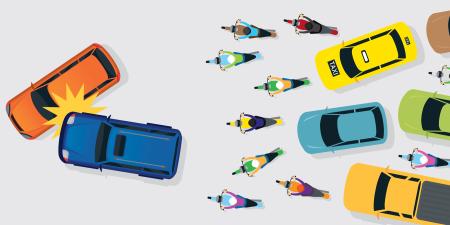Case
“How are you, Mr. Wagner?” asked Dr. Shore as he entered the exam room and greeted the elderly patient he had been seeing for over 15 years.
“I’m doing fine, Dr. Shore. My wife’s arthritis has been flaring up occasionally, so I help her and we get by. She takes her mind off the pain by staying involved with our church functions, the parties at the senior center, and babysitting our grandchildren. We have more of a social life now than we did when we were 25!”
“It’s great to hear that you’re so active. Before we discuss your diabetes and hypertension, do you have any particular concerns today?”
“No…,” Mr. Wagner responded, his voice trailing off. “Well, the biggest worry on my mind right now is working out insurance issues after a fender bender I was involved in last week.”
“Oh? What happened?”
“Lately I’ve been getting a little mixed up with directions. We go to church at least once a week and we always take the same route. I mean, I know where I’m going. It’s just that, for a second or two, I don’t know where we are. My wife hasn’t driven in years because of her arthritis, so I’m always the one behind the wheel. Usually I’m fine, but sometimes I wonder if my memory is going…it must be old age!” chuckled Mr. Wagner.
“Anyway,” Mr. Wagner continued, “it was one of those times when I was trying to figure out where we were. I thought I was paying close attention to the road, but somehow I ended up with this minor, but particularly annoying, fender bender. Luckily no one got hurt.”
Commentary
This case highlights a number of important points that arise when the safety of the general public must be balanced with the quality of life for a senior patient with some memory loss. Mr. Wagner is active and enjoys the social benefits of his lifestyle. His wife has arthritis, which imposes some physical limitations on her, and Mr. Wagner is the sole driver in the household. He is aware of some difficulties with his memory and driving, and he brings this up for discussion with Dr. Shore.
Transportation is essential for participating in a variety of out-of-the-home activities that can improve a person’s mood, self-efficacy, cognition, quality of life, and longevity. Driving is often synonymous with transportation in our society and remains the primary source of getting from place to place anywhere but in a large city, even for those in advanced age [1]. People who no longer drive are able to participate in fewer outside-the-home activities and have been shown to exhibit more depressive symptoms than their peers who drive [2, 3]. Despite the advantages of pursuing activities outside of the home, there may come a time when people need to make the transition to driving less frequently or not at all.
Safety
There is great variability in the factors that affect driving safety among aging individuals and no readily available way to identify them. Nevertheless there is much clinicians can do to become more aware of possible risk factors for unsafe driving and to make patients and families more conscious of the challenges that older drivers face. Signs that driving safety may be a problem include changes in health and in physical and mental function.
Physicians must be mindful of the functional manifestations of the underlying medical conditions their older patients have. Among medical conditions that contribute to driving risk are dementia, neurodegenerative disorders, vision disorders, sleep disorders, and conditions that adversely affect blood supply to the brain. The functions that most profoundly affect safe vehicle operations are vision, cognition (information processing speed), and physical ability. A number of widely available resources, such as those published by the American Medical Association and the Canadian Medical Association, enumerate relevant conditions and functional abilities, explain how to assess them, and list the reporting requirements in different jurisdictions [4, 5]. Algorithms for assessing the physical fitness of an aging driver are available in the AMA article and elsewhere [4, 6].
Physicians should also consider the medications a patient is taking—particularly those that might affect vision, cognition, or physical ability—when determining whether a patient is capable of operating a vehicle safely. When prescribing such medications doctors should discuss the potential effects and side effects with the patient and assign doses that are medically beneficial but minimize the effect on driving ability. Finally, doctors should document discussions in the patient’s medical record and provide the patient with a copy of instructions and care plans.
Improving Driver Safety
Recent studies have demonstrated that medical interventions can improve vision, cognition, and physical ability (flexibility and speed of movement) [7-9]. Evidence also suggests that educational programs including classroom and on-road training can enhance driving performance [10]. In older patients whose functional impairments are manifestations of underlying medical conditions, only small improvements may be possible.
As with any intervention, the first step is the patient’s recognition of the problem and his or her willingness to change. Mr. Wagner displays commendable insight into his possible deficits and seems open to examining the problem and changing what he can. Dr. Shore should address the factors that are most remediable first. If these initial interventions do not ameliorate the problem sufficiently, the next step is to phase out driving. In this particular case, it would be helpful to know whether Mr. Wagner’s wife is able to drive when her arthritis is not flaring up and whether they have other transportation resources available. It may be helpful to contact other family members, a social worker, or agencies like the Chamber of Commerce to find out about local transportation resources. If the patient is reluctant to consider driving alternatives, the physician must make clear why he or she is concerned. Mr. Wagner’s episode of getting lost is an indicator of cognitive difficulty. It would be worthwhile to review his medical conditions, vision, cognition, physical ability, and medications, with the idea of fitness for driving in mind. Physicians can also ask a patient or a family member about adverse driving events and can request that the family member ride with the patient and look for difficulties in vehicle operation and interaction with traffic. If this is not possible, professional assessments of driving performance can be obtained from community agencies that provide such evaluations or by licensing agencies (i.e., Department of Motor Vehicles). Family members can also help monitor and reinforce the need for recommended changes in driving practices.
Advice for Physicians
When discussing driving abilities with patients, you should be frank but supportive. Explain clearly why you are concerned and review these points with the patient and, if the patient will allow, with the family. Gather the information about the patient’s medical conditions, functional abilities, medications, driving performance, and driving safety—all that it takes to convince you, the patient, and the family either that the patient can continue to drive safely or that he or she cannot. If, in fact, the patient cannot continue to drive safely, present your recommendations as advice and allow the patient to decide how to proceed; follow up with the patient and family about whether changes have occurred.
Depending on the jurisdiction, and the severity of your recommendations, you may be required to report the patient to the licensing agency. The AMA’s Code of Medical Ethics directs the physician to report “medical conditions that would impair safe driving as dictated by his or her state’s mandatory reporting laws and standards of medical practice” [11]. When patients are reported to the licensing agency, the final determination regarding fitness to drive is made by the Department of Motor Vehicles.
Before reporting a patient, understand, disclose, and explain your responsibility to report to the patient. If you are not required to report, you may elect to allow the patient to act on your advice before involving the state. If, however, you believe that the patient is unlikely to follow your advice or that he or she poses a significant safety hazard to self and others, you may still want to report. Be sure to document all discussions in the medical record. Many states have medical advisory boards that are valuable sources of information on this topic. Print resources that outline potential approaches to discussing driving safety with patients are also available [4, 12].
In summary, this case features a patient who is aware of potential difficulties both in functional abilities and driving performance and raises these to his physician. As physicians, our goal should be to advise and support the patient, optimizing both mobility and safety, and work to achieve acceptable compromises when one or both of these is affected.
References
- Marottoli RA, de Leon CFM, Glass TA, Williams CS, Cooney LM, Berkman LF. Consequences of driving cessation: decreased out-of-home activity levels. J Gerontol B Psychol Sci Soc Sci. 2000;55(6):S334-S340.
- Jette AM, Branch LG. A ten-year follow-up of driving patterns among the community-dwelling elderly. Hum Factors. 1992;34(1):25-31.
- Marottoli RA, Mendes de Leon CF, Glass TA, et al. Driving cessation and increased depressive symptoms: prospective evidence from the New Haven EPESE. Established Populations for Epidemiologic Studies of the Elderly. J Am Geriatr Soc. 1997;45(2):202-206.
-
Wang CC, Kosinski CJ, Schwartzberg JG, Shanklin AV. Physician's Guide to Assessing and Counseling Older Drivers. Chicago, IL: American Medical Association; 2003. Accessed May 5, 2008.
-
Canadian Medical Association. Determining Medical Fitness to Operate Motor Vehicles: CMA Drivers Guide—7th Edition. Ottawa, ON: Canadian Medical Association; 2006. Accessed May 5, 2008.
-
Marottoli R. Older driver assessment. In: Osterweil D, Brummel-Smith K, Beck JC, eds. Comprehensive Geriatric Assessment. New York, NY: McGraw-Hill; 2006:443-463.
- Owsley C, McGwin G, Sloane M, Wells J, Stalvey BT, Gauthreaux S. Impact of cataract surgery on motor vehicle crash involvement by older adults. JAMA. 2002;288(7):841-849.
- Roenker DL, Cissell GM, Ball KK, Wadley VG, Edwards JD. Speed-of-processing and driving simulator training result in improved driving performance. Hum Factors. 2003;45(2):218-233.
- Marottoli RA, Allore H, Araujo KL, et al. A randomized trial of a physical conditioning program to enhance the driving performance of older persons. J Gen Intern Med. 2007;22(5):590-597.
- Marottoli RA, Ness PH, Araujo KL, et al. A randomized trial of an education program to enhance older driver performance. J Gerontol A Biol Sci Med Sci. 2007;621113-1119.
-
American Medical Association. Opinion 2.24 Impaired drivers and their physicians. Code of Medical Ethics. Chicago, IL: American Medical Association; 2006. Accessed May 5, 2008.
-
At the Crossroads: Family Conversations about Alzheimer's Disease, Dementia & Driving. Southington, CT: The Hartford; 2007. http://www.thehartford.com/alzheimers/brochure.html. Accessed May 5, 2008.



